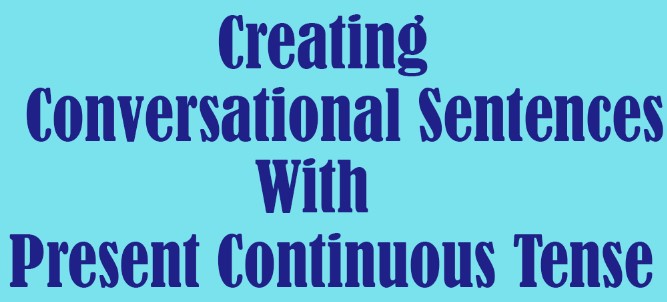Understanding the sentence pattern of Present Continuous Tense.
You can form conversational sentences in the Present Continuous Tense using the following sentence pattern:
Subject + to be + Verb + Ing
The Present Continuous Tense is also often referred to as the Present Progressive Tense. Before delving deeper into the Present Continuous Tense, it’s better to first understand the forms of “to be” and their corresponding subjects
Observe the following table:
| SUBJECT | TO BE | V + ing |
| I | am | V + ing |
| You | are | V + ing |
| We | are | V + ing |
| They | are | V + ing |
| He | is | V + ing |
| She | is | V + ing |
| It | is | V + ing |
When learning the Present Continuous Tense, you will usually encounter some contractions of the forms of “to be.”
The contractions are as follows:
I’m. =. I am.
Example: I’m cooking soup.
They’re = They are
Example: They’re playing football
He’s = He is
Example: He’s working in the office
Aren’t = are not
Example: They aren’t studying at school
Isn’t = is not
Example: She isn’t watching a movie
Several functions of the Present Continuous Tense.
There are several functions of the Present Continuous Tense that need to be understood to know how to use this tense correctly to form accurate conversation sentences.
1. Stating ongoing activities:
Example conversations:
Conversation 1:
+ : Where is Robert?
++: In the library. He’s studying mathematics.
+: Really? I saw him in the canteen a couple of minutes ago.
Conversation 2:
Robert is calling Alex, his classmate.
+ : Hello, Alex. What are you doing at the moment?
++ : I’m cooking soup for lunch.
+ : Let me know when the soup is ready.
Conversation 3:
+: Can I borrow this book?
++: Sure. Go ahead. I’m not reading it.
+: Thanks.
Conversation 4:
++: Look, that’s Richard, right? What is he doing in the park?
+: I think he is waiting for his girlfriend.
Long Conversation:
Ali: Hello, Emma. It’s Ali speaking. How are you?
Emma: Hi Ali. I’m just okay. But I’m busy at the moment. I’m doing my school assignment.
Ali: What about Albert? Can I speak to him?
Emma: I think he is doing his homework now.
Ali: And Alex? Is he free?
Emma: I’m sorry, he is going swimming with Richard.
Ali: Can I speak to Rudy?
Emma: Sorry, Rudy is playing football with Jonathan.
Ali: All right, can I speak to your cat?
Emma: He…he… That’s a good joke, but the cat is sleeping at the moment.
Ali: All right, sorry to disturb you. See you.
From these conversations, it can be understood that an activity has already begun but is not yet finished until now. In other words, the activity is ongoing when discussed.
2. Describe an activity that has been started, but the process is still ongoing until now.
It describes an activity that has not been fully completed yet.
Observe the following conversation:
Alex: I’m reading an interesting novel at the moment. I will lend you the novel if I have finished reading it.
Anggi: Really? May I see the novel.
Alex: Sorry, I don’t have it with me right now.
Anggi: That’s all right. No problem.
From the conversation , it can be understood that Alex is not currently reading the novel when talking to Anggi. Alex has already started reading the novel, but he has not finished reading it until now.
3. Discussing activities that are happening in the current period.
The current period refers to things that are happening recently, today, this week, this afternoon, and so on.
Observe the following conversation:
Conversation 1:
+ : I haven’t seen Joana this morning.
++ : Joana is not working this week. She is on holiday.
+: Really? No one told me so.
Conversation 2:
+: Do you know where Budi is?
++ : I know, but I think he is working very hard today, he has a lot of work to do.
+: All right. Thanks.
Conversation 3:
+: I wanna meet Richard, but it’s hard to reach him.
++ : He’s looking for a job. That’s why it’s so hard to meet him at home this week.
+: Oh, I see.
4. Talking about recent changes that have occurred.
Observe the following conversation:
Conversation 1:
+: We have to take care of rare animals like the South China tiger.
++ : Right. The population of the South China Tiger is decreasing slowly.
+: Exactly.
Conversation 2:
+: The weather now is really unpredictable.
++ : I agree with you. The climate is changing.
Conversation 3:
+: My English is getting better after I take an English course.
++ : That’s cool, man.

